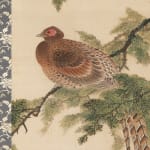




Shiokawa Bunrin (1808 - 1877)
Bird on Branch , ca 1850
Sumi Ink and Color on Silk
42’h x 16”w ; scroll, 78-1/2”h x 21-1/2”w
Further images
Shiokawa Bunrin was born in Kyoto in 1808 as a son of a samurai. At age 14, upon his father’s passing, he moved to Fushimi, Kyoto to live with his...
Shiokawa Bunrin was born in Kyoto in 1808 as a son of a samurai. At age 14, upon his father’s passing, he moved to Fushimi, Kyoto to live with his relatives. Little is known of his early career until the 1850’s when he appeared as an established artist working in the Imperial Palace. During the chaotic years before the Meiji Restoration, he stayed away from the center of Kyoto and spent time studying the collections of many temples and shrines of the region. He also encountered western paintings during this period. Bunrin was a major artist, who greatly influenced the Kyoto style of painting in the early Meiji Era through his deep knowledge of classical Japanese art and his exposure to Western works.
The first thing that catches the eye is the intricacy of the plump pheasant perched high above the ground on a branch. The details and realism of the work speak to the skills of the artist and his wide range of expression. Compared to his other works in this gallery, this rendition of a pheasant communicates a different tone and frame of mind. The painting is presented on a fitting mounting, with a decadent floral pattern that matches the richness of the pheasant. It is an elegant piece with a flavor from the past. It can create a beautiful jolt placed in the perfect place.
The first thing that catches the eye is the intricacy of the plump pheasant perched high above the ground on a branch. The details and realism of the work speak to the skills of the artist and his wide range of expression. Compared to his other works in this gallery, this rendition of a pheasant communicates a different tone and frame of mind. The painting is presented on a fitting mounting, with a decadent floral pattern that matches the richness of the pheasant. It is an elegant piece with a flavor from the past. It can create a beautiful jolt placed in the perfect place.
Signup for our Newsletter
You will receive two emails a month from us. One introduces artworks and design works from Kyoto's hidden sources and the other is stories from Misako, sharing insights into Japanese culture.
* denotes required fields
为了回应您的查询,我们将根据我们的隐私政策处理您提供的个人数据。




